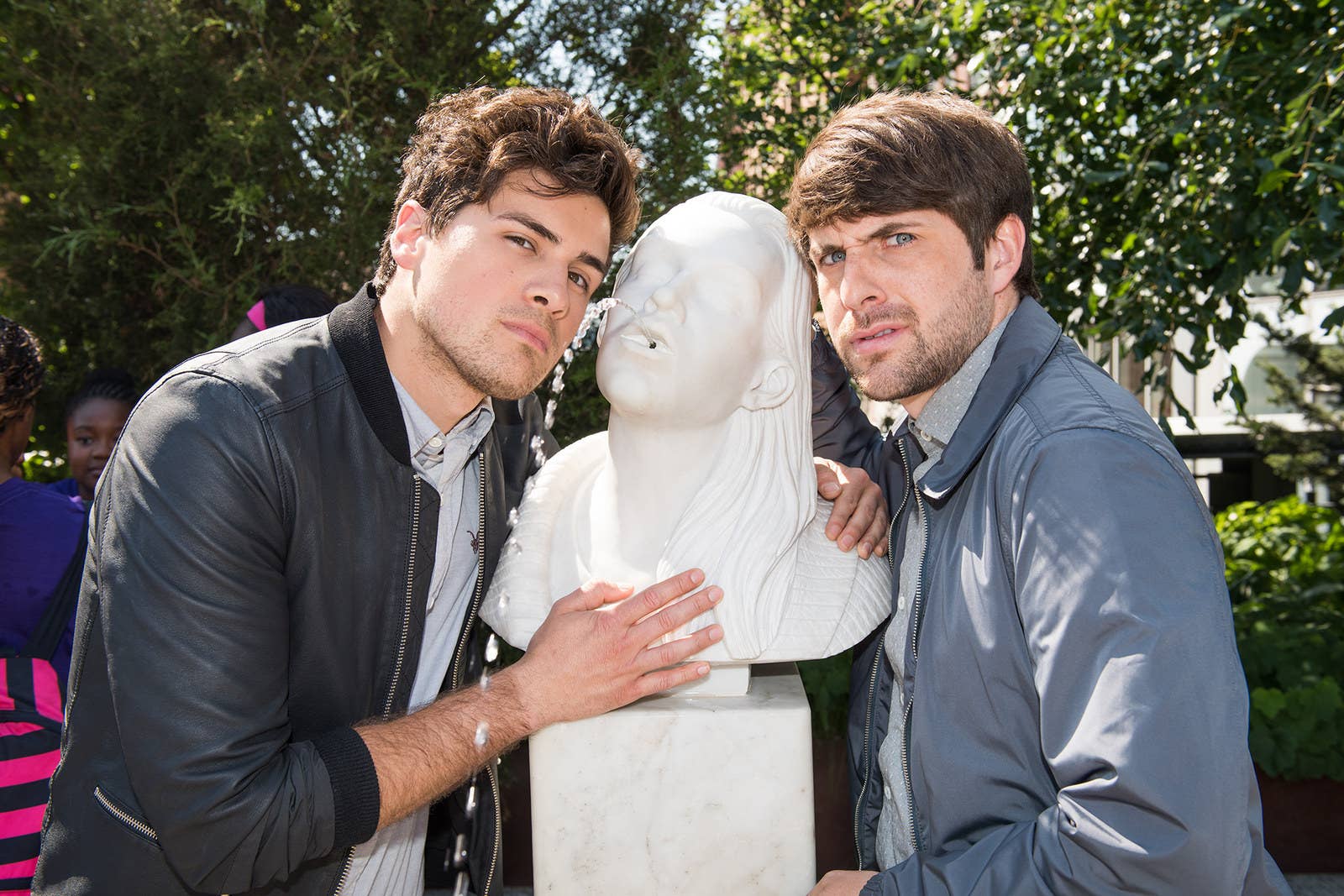
Anthony Padilla and Ian Hecox, better known as Smosh, are on the High Line — a long, skinny stretch of old tramway turned park in Midtown Manhattan — and taking mildly obscene photos with a fountain shaped like a woman’s face. The boys-to-men of Smosh are naturals at this sort of freestyle mugging — they’ve spent years transforming the most mundane parts of their homes and neighborhoods into playgrounds for their YouTube videos, which have been viewed over 7 billion times.
Up to this point, the pair — in New York to promote Smosh: The Movie — had escaped recognition. In Manhattan, they just look like two handsome white guys: one (Anthony) who resembles an olive-skinned James Dean, the other (Ian) like a good-looking computer programmer. It’s not until they pull on the hammy, troublemaking mask of Smosh that they get recognized.
The first time, it’s from a tween girl who, standing 15 feet back, begins to weep. Her mother is speaking to her in Spanish, trying to calm her down as she goes through the very particular waterfall of emotions that comes with superfandom. As she musters the courage to step forward, the publicist asks, “You wanna take a picture with them?”
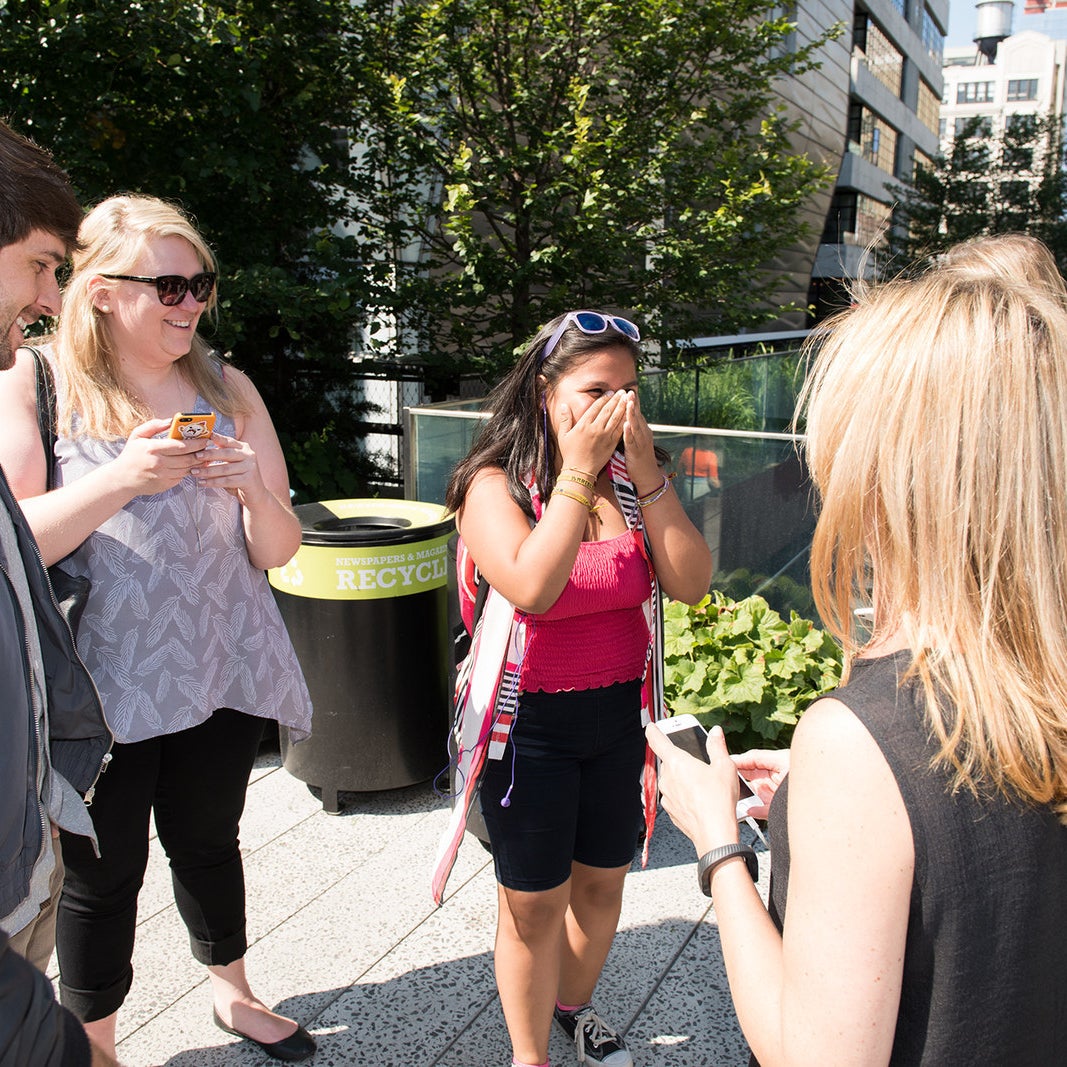

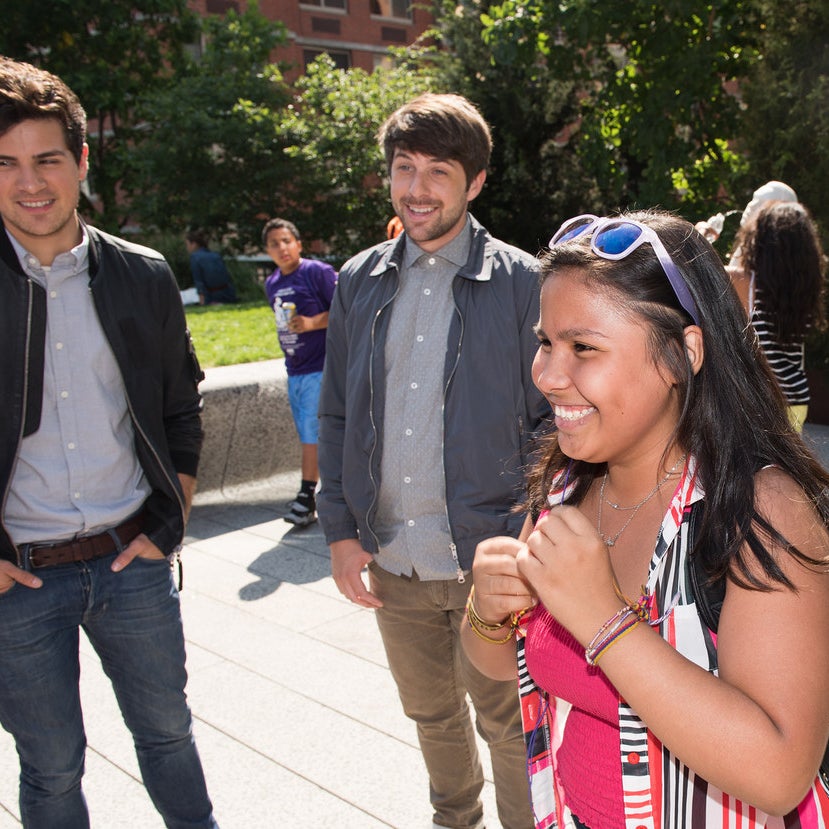
Hecox motions for her to stand between them, and the girl manages to hold it together long enough for her mom to snap a picture and tell the guys she’s visiting from Ecuador, where there's a large fan base for El Smosh, one of 6 Smosh spin-off channels. She darts away to start her real freak-out as she looks at the photos on the screen: That’s me, that’s those guys from the internet, that’s us together in New York, that’s my ticket to minor fame among my friends for the next three days, at least.
The photo op attracts the attention of a group of kids from a local day camp, dressed in bright pink and purple shirts so their counselors won’t lose them, and a mini-frenzy begins, scored with cries of "Oh my god, oh my god, I know them” followed by a flurry of selfies. “Thanks, you guys!” Padilla shouts as we walk away, a chorus of “I love you, Anthony!” shouted in return.
Over the next 10 minutes, five different groups would stop, including a cluster of frat-looking guys and a boy with the spirit of a 44-year-old middle manager who firmly shakes Hecox’s hand and says, “I just really enjoy your work.”
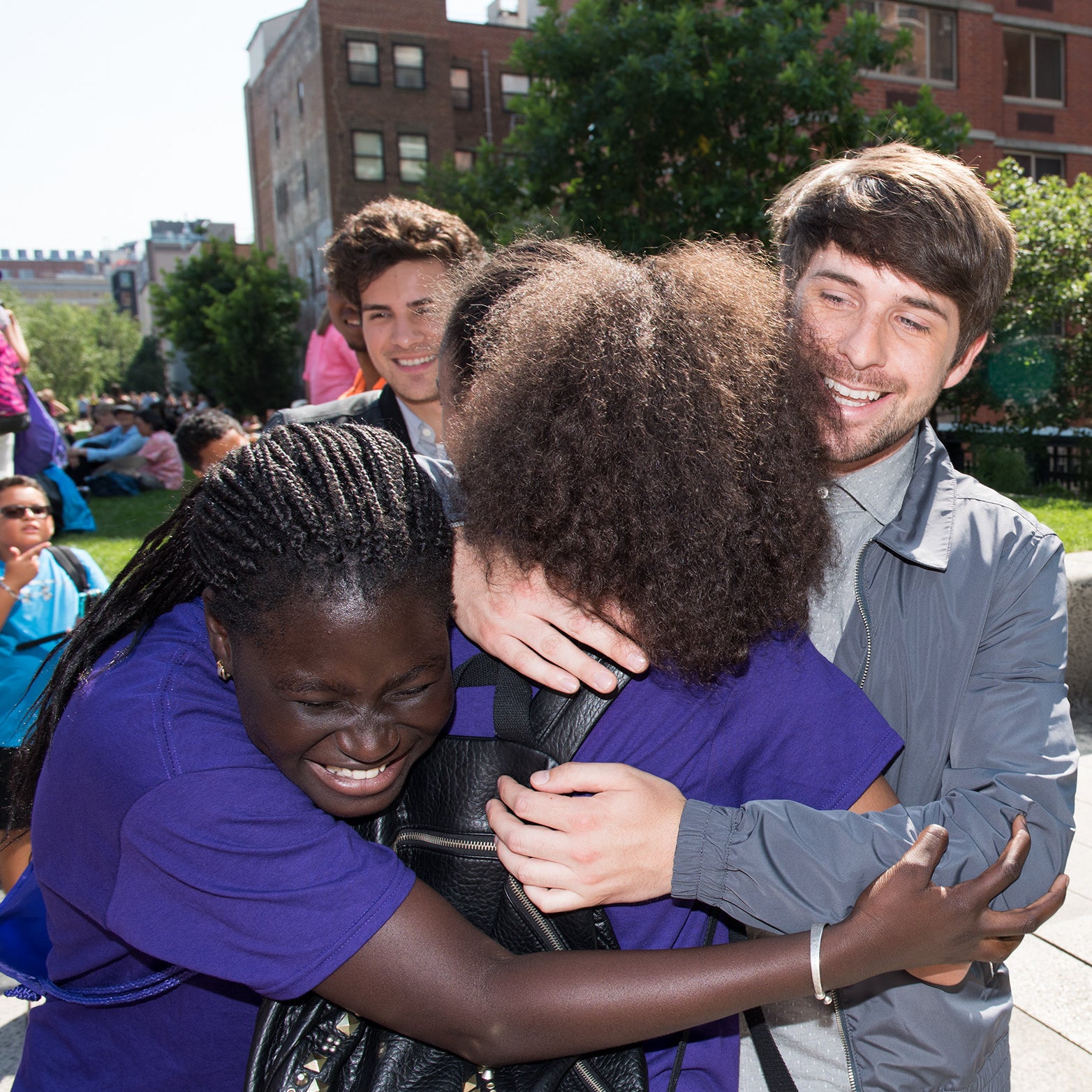

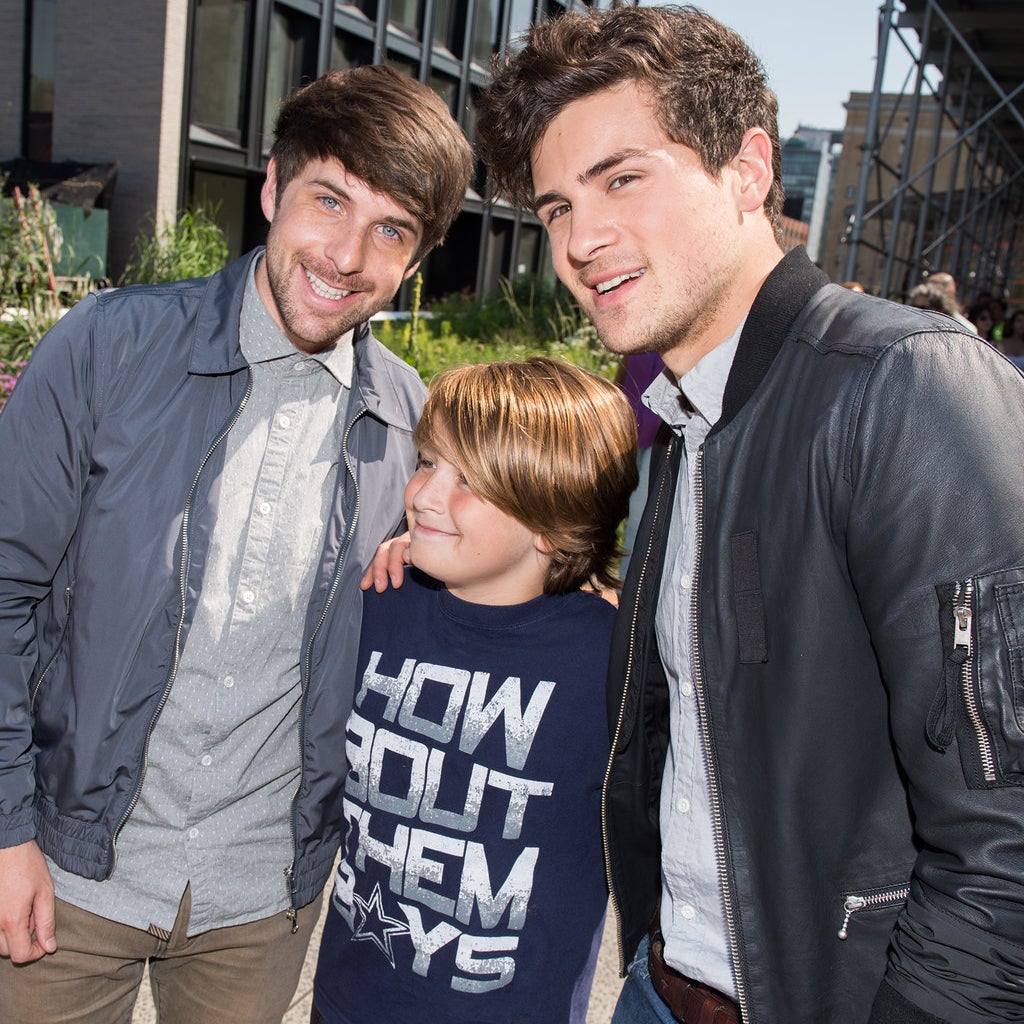
If that all sounds like pretty standard teen idol fare, you’re partly right. After the High Line, the guys went for a photo shoot at Seventeen. "And tomorrow," Hecox brags, "we're going to...WAIT FOR IT...J-14."
But Hecox and Padilla, both 27 years old, are no One Direction — nor are any of the slew of cherub-cheeked teens produced by the Disney machine. Like Cole and Dylan Sprouse or Drake Bell before them, their massive fandom is built on an abundance of elastic faces, simple gags, play fighting, and misheard words repeated until they sound like profanities. Yet instead of being scripted by adults, Hecox and Padilla have always been their own producers.
Which isn’t to say that they’re not cute: When asked about her favorite things about Smosh, Olivia, a middle schooler from New Jersey, told me, “I really like it when Anthony is shirtless.”
Yet the two have spent the last 10 years turning the things that made themselves laugh in high school into a multipronged brand turned production house. They’re producers, writers, editors, and authors of themselves and their images. If you find their humor juvenile, you’re missing the point: It’s not for you. By sticking to their brand — blowing it into the far corners of the YouTube universe, replicating it with a growing cast of Smosh-minded actors, extending it onto shoot-off channels and video games and apps — Smosh have found themselves in the most secure place of the new digital celebrity universe.
In 2013, Forbes estimated they’d pulled in $10 million in revenue. The Smosh network of channels — some featuring Hecox and Padilla; others, like Smosh Games, simply channeling their ethos — boasts over 35 million subscribers. But all that could go away when their faces start looking like the faces of the dads of the kids who watch instead of the kids themselves. Like Leonardo DiCaprio before them, who started producing films to create a future for himself that didn’t involve teen idol-dom, Smosh has figured out the secret of Hollywood, digital or not: Instead of becoming subject to the whims of the industry, they’ve built themselves into its infrastructure.
Their business strategy — diversifying and expanding their content, hiring more actors, and partnering with ex–Disney Television exec Barry Blumberg, who helped bring them under the umbrella of digital production house Defy Media — has been well-covered, mostly in articles that attempt to explain why adults should care about two guys whose most popular videos involve sparring with various food items. Namely: money. They make it. Not in superhero blockbuster tentpole numbers, but in the sort with profit margins — and direct access to one of the most coveted demographics — that makes people take notice.
But none of those profits would be possible if young people — millions upon millions of them — didn’t find them likable, relatable, and lose-your-shit hilarious. That’s the difficult thing to understand about Smosh: Their appeal lies not in their difference or uniqueness. It has nothing to do with novelty or even innovation. They’re normal suburban guys doing the thing that normal suburban kids love to watch: make magic, however basic, out of boredom.
To call Smosh facile or moronic diminishes their skill. These videos might look and feel like they were filmed, impromptu, on a grass patch in front of their office, but they’re actually the product of weeks of pitching, workshopping, filming, and editing. The end products are professionally made to look like amateur products: It takes a lot of work to make something look this spontaneous.
But it also makes Smosh feel far less mediated, and far more relatable, than any movie star or traditional celebrity. When a Variety survey from 2014 asked 1,500 high school students, judging relatability, engagement, and generalized influence, Smosh ranked No. 1 — beating out traditional stars Jennifer Lawrence (No. 7), Daniel Radcliffe (No. 12), and Leonardo DiCaprio (No. 20), as well as all the other YouTube stars on the list.
The reasoning is simple: They might not have been the most popular in their own suburban high school, but they’re the coolest kids — the ones doing the skits at the all-school assembly — in the universe of YouTube celebrity, where the nerds, awkwards, emos, gamers, and theater kids assemble and turn their musings, relationships, and drama into monetized content.
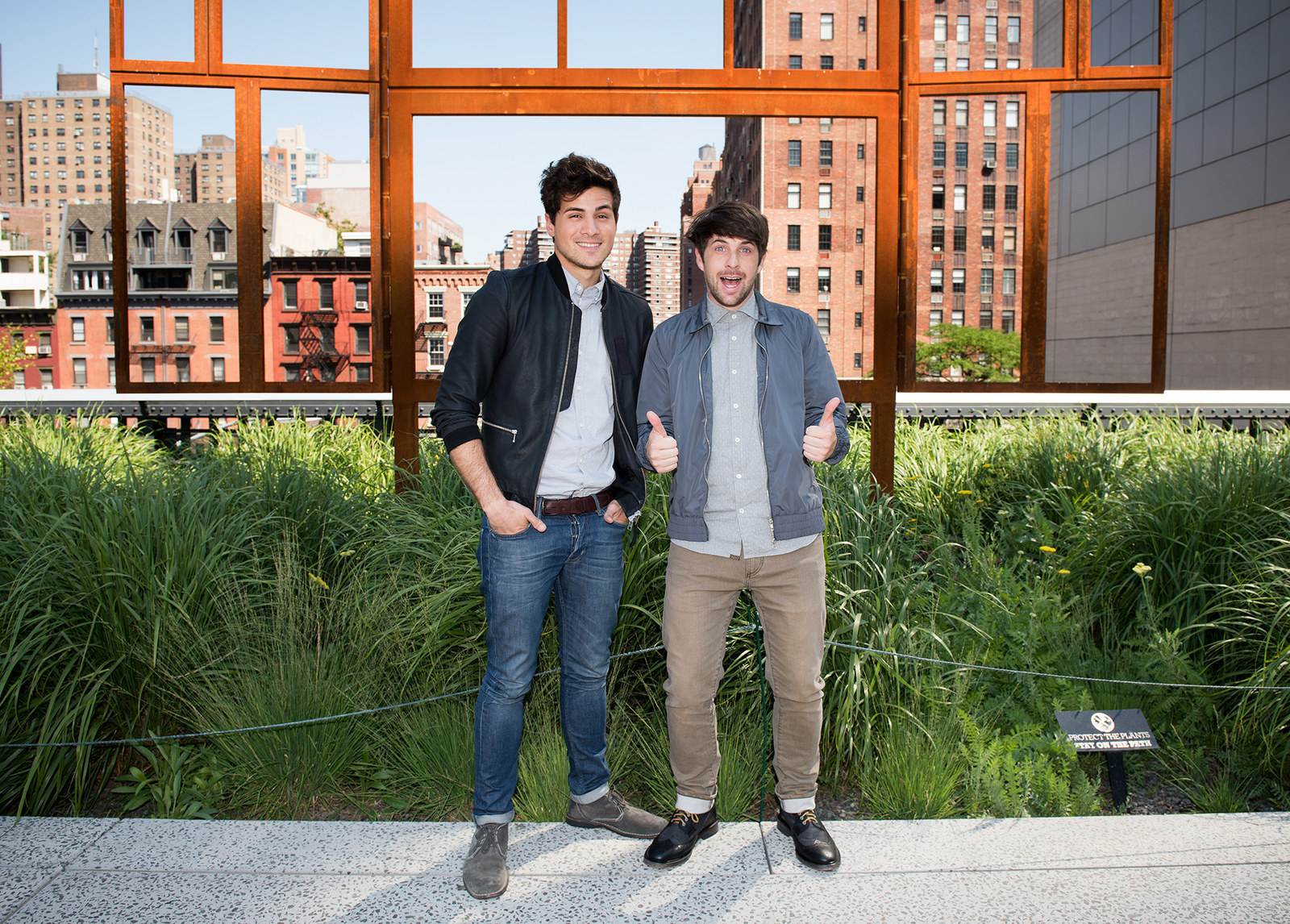
Hecox and Padilla grew up in Carmichael, California — a middle-class suburb of Sacramento that’s 80% white. They’ve been friends since elementary school, where they lived spectacularly normal childhoods. Hecox played soccer for a bit; Padilla did karate for six months in sixth grade: “I had, like, an orange belt. But most of the kids in there were 6 years old, so I was like, ‘I’m outta here.’”
He says this as he plows through a salad of endive and radicchio — hold the cheese — at the sort of velvet-curtained Times Square steakhouse where old-school newspapermen used to go for three-martini lunches. Padilla, a vegan, is eating a spare salad with a side of fries his publicist ordered for him, wedged next to Hecox and a cluster of publicists in a high-backed leather booth.
They’re winding down after taping a segment on the Today show, where they hammed it up on cue and flirted with Kathie Lee and Hoda, and are dressed a notch nattier than they ever appear in their videos, with expensive-looking jeans and perfectly fitted jackets.
Middle school was rough for Hecox, Padilla less so: “He was a good-looking little middle schooler,” Hecox says. “He got girls.”
“Yeah, uh, I did,” Padilla replies.
You can get girls and still be miserable, of course, but that wasn’t Padilla. He glided through with that face and those eyes. Hecox was the type of guy who saved for months for a pair of K-Swiss shoes, only to be teased the first day he wore them: “Oh, you got some GAY Swiss?”
“But of course I still wore them,” he said. “They were like 70 bucks!”
They moved on to high school, where Hecox ran cross-country. “It turns out that cross-country just makes you even more of a loser. Like, walking around with a letterman jacket from cross-country is just, like, full of shame,” he said, as Padilla giggled next to him. Still, “at our high school, we weren't the losers, but we weren't the coolest kids either. We just kinda blended in."
Padilla didn’t play sports and didn’t join clubs. “Just constant video games. I didn’t think we lived in a small town until I moved to L.A.,” he says. “Now I go back and I’m like, wow, there’s NOTHING to do here! That’s why I would spend every day just eating fast food and playing games.”
“Yeah,” Hecox adds. “I guess that's why we started doing the videos."
Suburban ennui: It can lead to drugs, mischief, depression, or, in the case of Smosh, some sort of creative diversion. As teens, they spent hours, days, weekends making basic Flash animations, lip-synching to video game theme songs, and eventually posting to YouTube on an account named for their website, smosh.com, derived from an inside joke about a guy who mispronounced “mosh pit” as “smosh pit.” The things they'd made to make themselves and their friends laugh turned into things that made thousands, then millions, of strangers laugh.
Padilla’s favorite comedian is Jim Carrey and Hecox is obsessed with Spaceballs, and you can see the influence of both all over their comedy. From Carrey, the plastic-faced reaction shots, the madcap energy; from Spaceballs, the pleasure found in a pitch-perfect spoof of a beloved pop culture artifact.
That sort of nostalgia and knowledge is central to Smosh’s “[BLANK] in Real Life” series: In “Pokemon in Real Life,” posted in 2011 and currently topping 45 million views, they take a game that animated their childhoods and lay its logic flat, re-enacting the halted, nonsensical nature of Pokémon’s gameplay to highlight its absurdity.
It’s not something that marketers for Nintendo have ever thought about, but in many ways, it gets to the authentic heart of the game, trading on the sort of knowledge that years of experience can yield. The humor is broad, but it stems from hours of frustration with a game with which millions of others are deeply familiar. Smosh takes an average experience and rotates, needles, and massages it until the humor shakes out. It’s brilliant, in its way.
The same goes for the “Every [BLANK] Ever” series, which lampoons situations with which even 16-year-olds have become weary: Having a Dad, Going to a Party, Receiving Snapchats. “Every Instagram Ever” skewers the work that goes into every “effortless” Instagram post, but it also cuts to the quick of the particular anxiety of performing social media: “It’s only Thursday for 13 more hours, and if I don’t post an old photo of myself for Throwback Thursday, I’ll be missing out on a huge trend...no one at school will talk to me, I’ll never get a girlfriend, and I’ll end up dying alone.”
Overblown, but not by much. Which, again, is the attraction of Smosh: They’re fluent in the anxieties, annoyances, and everyday experiences that animate teen life. No matter that they're 27: Those things don't change, even if the technology does. It's that insight, more than any other, that's fueled their success: They're not acting like teenagers so much as channeling teen concerns and pleasures.
They're also unconcerned with the macro stuff — there’s no Smosh video called “Every Student Loan Payment Ever,” for example, or “Racism in Real Life.” Instead, they focus on the experiences that feel like they absolutely matter when you’re living through them, even if they fade in importance as you age. Dads being weird, moms being overbearing, friends being fickle, video games being the worst and best part of your life.
Smosh is relatable — and average — in other, even more crucial ways. Their politics, if you could call them that, mirror the social liberalism that various research groups have identified as those of the next generation: a generation in which being gay, or having gay dads, is totally normal. The troupe of Smosh-like actors they’ve amassed as co-stars are a mix of race and ethnicity; when asked if they hired so as to deliberately attract different demos, they look as if no one’s ever asked them the question before. “We just hired the people who were best for the job,” Padilla said. “But we did try to make sure that we had a split of guys and girls.”
Which isn’t to say that Smosh is always PC — their depiction of gay dads, for example, veers into feminized stereotypes; “If Guys Had Girl Problems” frames the imperative to wear makeup or dealing with sexist cops as things that guys would actually enjoy. But those scenes are the exception, not the rule; recent videos have showed an increased sophistication not only in plotting — “Every Game of Thrones Ever” is them at their best — but production, costuming, even acting. It’s still the Smosh brand, it’s just, well, better? Prettier? Cooler? Or maybe just equipped to weather Hecox and Padilla’s decadelong transition into adulthood.
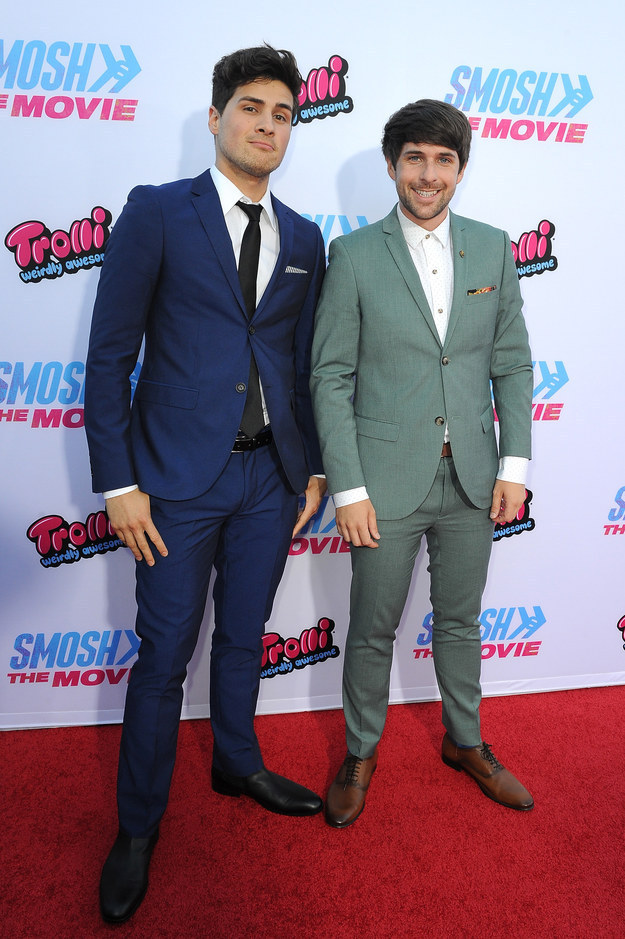
That’s part of the goal of Smosh: The Movie, which functions as an 84-minute Smosh video, but with a narrative that’s pure internet meta: Padilla and Hecox are going to their five-year high school reunion, where Padilla hopes to meet up with an old crush — but they have to get YouTube to take down an embarrassing (and super-viral) video of him before they get there. During their attempts to take it down, they meet a series of actual YouTube stars — Jenna Marbles, Grace Helbig, Shane Dawson — and go to the YouTube headquarters, where they appeal to “Mr. YouTube” (Michael Ian Black) to take it down.
The movie had a red carpet Hollywood premiere on July 22 — attended by dozens of fellow YouTube stars — but won’t be released in theaters. Instead, it’ll be distributed in the way that Smosh fans have become accustomed to accessing their material: online. They’ll pay $9.99, but as Grace Helbig’s Camp Takota evidenced last year, fans are willing to pay for immediate and seamless access to this sort of extended, even if more traditional, content.
But Smosh: The Movie also encapsulates just how in between celebrity worlds Anthony and Hecox have positioned themselves. They have no desire to become traditional movie stars — as Hecox says, “YouTube works best when YouTube isn’t trying to do other things.” They don’t want to attempt a Grace Helbig–style crossover to “traditional” media. They want to stay in their lane. They love their lane. It’s provided nothing but smooth driving for them.
Yet promoting a movie also entails stepping out of the familiar sphere of YouTube celebrity and into the world of traditional publicity. During their day in New York City, I watched them do press with the Today show, Entertainment Weekly, and Seventeen — all very traditional media outlets. They were styled: Walking between outlets, Hecox told me he hated his shoes, which had slight heels in order to decrease the inches between his height and Padilla’s; Padilla hated all of his stylist-provided options, so he just wore his slightly rumpled shirt and leather jacket instead. They had press training (Hecox: “We basically learned how to make our answers interesting”) and were coached on how to deflect questions about potential girlfriends. When Kathie Lee asked about their love lives, Padilla cheekily replied that “I have this pen-pal in Alaska, we’ve been writing for a few years, I think I might meet her soon” — an answer for which his publicists praised him after the fact.
They also have to deal with the sort of industry issues from which YouTube stardom has insulated them, like having someone else (Alex Winter, better known as Bill from Bill & Ted’s Excellent Adventure) direct their content, or sitting back as their co-producer, YouTube production house AwesomenessTV, cuts the trailer. And then there was the MPAA.
“There’s actually a moment in the trailer that the MPAA made us cut from the film in order to keep it PG-13,” Padilla explains, “the part when Ian goes, ‘Is it weird to say that the closer this guy gets to my ass, the better it feels?’ In the actual movie, we had to ADR [voiceover] it to say, ‘Is it weird to say that I want this guy to massage my butt all day?’ or something weird like that.”
“That was our biggest struggle,” says Hecox. “They went way safe on everything. In the movie, my username is supposed to be bigrod69, and they made us change that to bigrod91.”
On YouTube, they say all the JV cuss words — shit, damn, ass, hell — freely, and bleep “fuck” in such a lazy way that only a person who’d never heard the word wouldn’t get the meaning. But the MPAA would rather they fake-kill some humans than use the number 69.
“The comparison we like giving is to Jurassic World. People are getting torn apart” — “Like, literally, blood splattering on the lens,” Padilla interjects — “there’s like mass murder going on, and it’s PG-13. And we can’t even say, ‘Sorry I’m such a dick.’”
They’re also dealing with the reality of sustained and total visibility — but in a slightly different way than, say, Chris Pratt. Walking down the High Line in the afterglow of their first fan mob, they try to distinguish themselves from other types of celebrities. “I mean, we don’t have people following us around photographing us buying stuff at stores or anything,” Padilla says.
So no Us Weekly feature on “YouTube Stars: They’re Just Like Us”? Padilla explodes in laughter at the thought: “No, because everyone knows it already.”
But where does Smosh end and Padilla and Hecox start? They regularly post Snapchats with their current location; Padilla did a “Draw My Life” video, using a whiteboard to go into detail about his past; for several years, he filmed every day of his relationship (with fellow vlogger Kalel Cullen) and posted it online, including a wedding proposal. (The pair have removed evidence of the relationship from YouTube, but enterprising fans periodically surface and repost videos.)
“But that felt kinda horrible,” Padilla explains. “It was fun at first, but it was just too much. I live more comfortably now that I’m a little more private.”

Which isn’t to say that they lie about their relationships: Their fans are the savviest of detectives. And unlike other YouTube performers, who maintain an image of singlehood (or heterosexuality) so as to maintain an aura of romantic availability, Hecox says “there’s not so much of that old thing where, like, ‘Oh, you’re taken, so that’s totally destroyed my life.’” Fans figure out love interests and “are actually really supportive and happy you’re dating someone.” Hiding a relationship “just doesn’t fly anymore in the world we’re in, a post–Tom Cruise world. Being able to keep a secret — that no longer exists.” Fans can deduce potential girlfriends (as they do on Tumblrs like “Smosh Rumors”), but, for privacy, the pair choose not to confirm any theories.
Both also balk at the notion that any fan has the “right” to know anything about them. “They don’t have the right,” Padilla says. “People think they deserve a certain amount, but you can never give them enough. They always want to know more.”
So they’ve figured out a balance: enough to satiate fans, but not so much as to lose themselves into the vortex that is the monetization of the self. Which, ultimately, is why Smosh is posed to succeed while other YouTube stars will blaze out: Their product isn’t themselves, but a style of comedy whose appeal is never-ending. And with an industrial infrastructure set up around them, they can expand that humor into every new corner, app, and distribution method.

They’re goofs, but they’re also businessmen. And if you’re listening closely you can hear undercurrents of their savvy. Over the course of the day, Hecox repeatedly refers to Smosh material as “content” — never videos, Vines, Snaps, or Instagrams, but “content” that can be exploited across the Smosh universe. They started off as producers who just happened to star in their videos; 10 years later, their posture is the same. “Everyone is always asking about what we’re gonna do in 10 years,” he explains. “And we don’t know if we can do the same thing, but we know we’re going to be doing something. Getting new people involved, evolving with the times.”
As the guys approach the end of the High Line and descend to their waiting SUV, one of their publicists tells them, “All right, you can take your jackets off now.” After they peel them off, it’s clear they’ve been sweating the whole time. The outfits, like the slight smudge of makeup that’s now melting off their faces, is part of the public face of Smosh. It can be uncomfortable. But what matters, at least for now, is that they can take it off — even if they have to wait for the publicist to give them the OK.
The next day, they’ll fly back to Los Angeles and return to the thing that’s always been at the heart of their appeal, that has absolutely nothing to do with red carpets or image maintenance or wearing things that make them sweat in the sun. There, they’ll make things, maybe starring them, maybe not, but make them — in only a slightly modified version of what they did as 17-year-olds, toiling with one of their dad’s cameras, teaching themselves how to edit. Things that make them feel less bored and more alive.
If all that sounds trivial, it shouldn’t. As Olivia, the superfan from New Jersey, explained over email, “They help me get through tough times at school with mean girls and growing up. I turn them on and tune others out.”
That’s what we all use entertainment for: Sometimes it makes life richer, or more complicated, or textured, or tragic. But sometimes, especially when you’re a 13-year-old girl, it does something even more crucial: It makes life, however momentarily, that much more bearable. Open up YouTube, click a link, and the coolest kids in high school are talking to you from the safety of your bedroom. It’s only three minutes — but maybe, probably, that’s enough.

